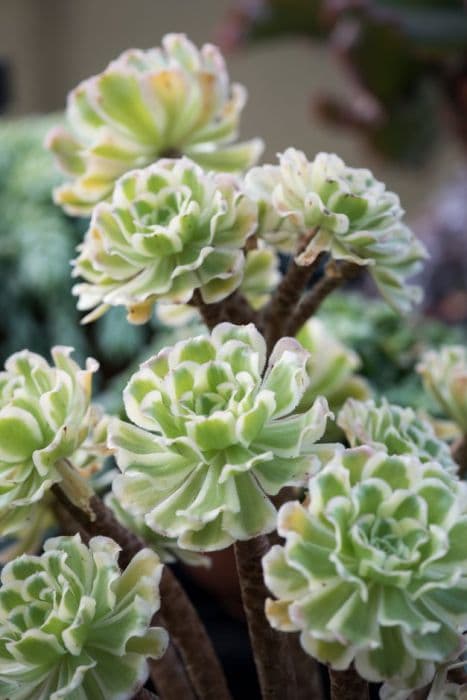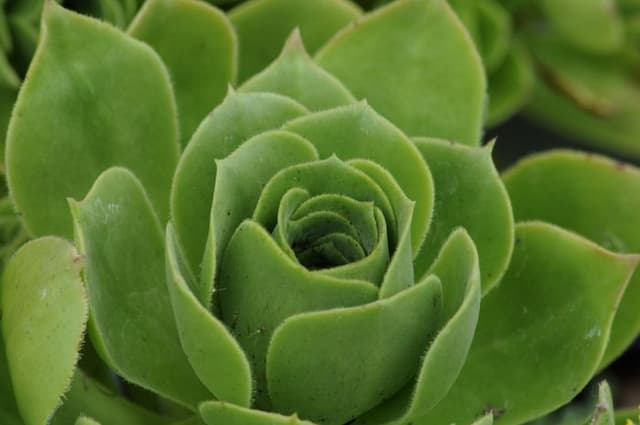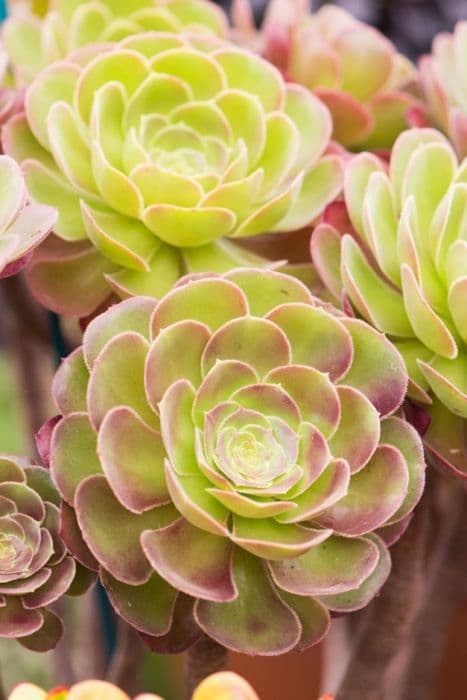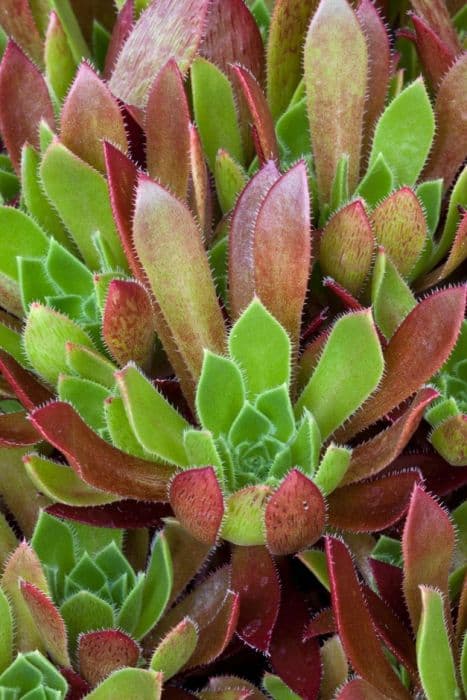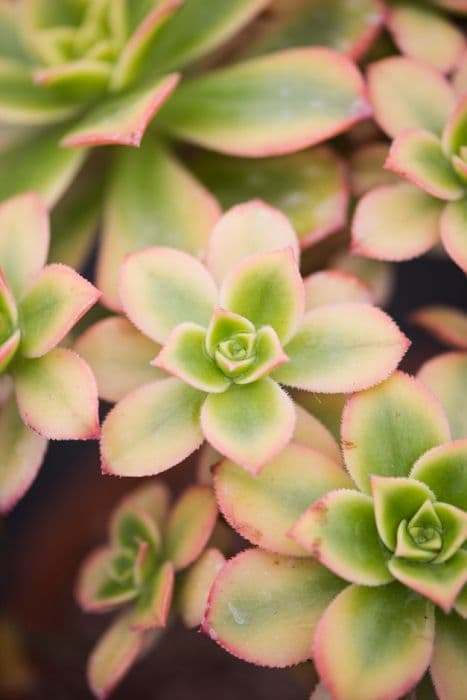Stonecrop Hylotelephium telephium 'Strawberries and Cream'

ABOUT
'Strawberries and Cream' is a captivating plant with a striking visual appeal that draws the eye in any garden setting. The foliage of this plant features a blend of hues that can include shades of green with creamy white edges, giving it a variegated appearance that resembles a swirl of strawberries mixed with cream. As the seasons progress, the color of the leaves can deepen or change, adding to the dynamic display of this plant variety. In terms of flowers, 'Strawberries and Cream' creates an attractive contrast with its foliage. The blossoms emerge in clusters, forming dense flower heads that may resemble a collection of tiny bouquets. These flowers typically bloom in a vibrant shade akin to pink or rosy-red, which further amplifies the plant's resemblance to its namesake of strawberries with cream. The flowering period adds to the visual interest of the plant, drawing pollinators and adding a lively touch to its overall demeanor. The plant is also recognized for its succulent-like leaves, which are fleshy and can store water. These leaves grow in a whorled or spiral pattern along the stems, giving 'Strawberries and Cream' a lush and robust appearance. The juxtaposition of the succulent leaves and the delicate flower clusters creates a pleasing texture contrast that is both visually appealing and tactile. Overall, 'Strawberries and Cream' is a delightful plant that offers a versatile look for a variety of garden themes, from traditional cottage gardens to modern landscape designs. Its unique coloration, stunning flowers, and succulent foliage make it a prized addition for gardeners seeking an ornamental plant that provides beauty throughout its growing season.
About this plant
 Names
NamesFamily
Crassulaceae
Synonyms
Orpine, Livelong, Frog's-stomach, Harping Johnny, Life-everlasting, Live-forever, Midsummer-men, Orphan John, Witch's Moneybags
Common names
Sedum telephium 'Strawberries and Cream'.
 Toxicity
ToxicityTo humans
The plant commonly known as Stonecrop is generally considered non-toxic to humans. However, as with many plants, sensitive individuals may experience mild irritation or an allergic reaction upon handling or ingesting parts of this plant. It is always advisable to avoid eating any part of ornamental plants due to potential individual sensitivities or the possibility of stomach upset.
To pets
Stonecrop is also known to be of low toxicity to pets, such as cats and dogs. While it is not commonly associated with serious poisoning, ingestion may lead to gastrointestinal discomfort, such as vomiting or diarrhea, especially if consumed in large quantities. As pets can have individual sensitivities, it's best to prevent your pets from eating this ornamental plant.
 Characteristics
CharacteristicsLife cycle
Perennials
Foliage type
Deciduous
Color of leaves
Variegated
Flower color
Pink
Height
1-2 feet (30-60 cm)
Spread
1-2 feet (30-60 cm)
Plant type
Succulent
Hardiness zones
3-9
Native area
Europe
Benefits
 General Benefits
General Benefits- Aesthetic Appeal: Adds vibrant color and texture to gardens with its creamy variegated foliage and strawberry-pink flowers.
- Drought Tolerance: Once established, it requires minimal water, making it ideal for xeriscaping or drought-prone areas.
- Low Maintenance: Requires very little care once established, making it a good choice for busy gardeners or those new to gardening.
- Attracts Pollinators: Blossoms attract bees, butterflies, and other beneficial pollinators, supporting local ecosystems.
- Seasonal Interest: Provides year-round interest with its foliage in the growing season and dried flower heads in winter.
- Deer Resistance: Its texture and taste are typically unappealing to deer, reducing the risk of damage from wildlife.
- Soil Adaptability: Can thrive in a variety of soil types, although it prefers well-draining soil.
- Suitable for Containers: Can be grown in pots or containers, making it versatile for patios, balconies, or small spaces.
- Easy to Propagate: Easily propagated by cuttings or division, allowing gardeners to expand their collection or share with others.
 Medical Properties
Medical PropertiesThis plant is not used for medical purposes.
 Air-purifying Qualities
Air-purifying QualitiesThis plant is not specifically known for air purifying qualities.
 Other Uses
Other Uses- Edging: Hylotelephium telephium, commonly known as 'Strawberries and Cream', can be used as a colorful, low-maintenance edging plant for walkways and garden borders.
- Groundcover: It can serve as an attractive groundcover, spreading to fill in gaps and suppress weeds in garden beds.
- Rock Gardens: Given its succulent nature and drought tolerance, 'Strawberries and Cream' is ideal for adding texture and color to rock gardens.
- Fairy Gardens: The small, intricate leaves and stems make this plant a whimsical addition to fairy gardens and other miniature garden designs.
- Potted Combinations: It can be combined with other succulents and drought-tolerant plants in container arrangements for patios and balconies.
- Livestock Feed: In some regions, the leaves may be used as emergency fodder for livestock during drought conditions.
- Green Roofs: This succulent's hardiness and low profile make it suitable for use in green roofing projects to help reduce building energy costs.
- Crafting: The colorful leaves and stems can be used in dried floral arrangements or as natural crafting materials.
- Garden Art: Planted in creative patterns, 'Strawberries and Cream' can be used to create living garden art due to its distinctive coloring.
- Educational Use: The plant can be used in educational settings to teach about succulents, xeriscaping, and garden design principles.
Interesting Facts
 Feng Shui
Feng ShuiSedum is not used in Feng Shui practice.
 Zodiac Sign Compitability
Zodiac Sign CompitabilitySedum is not used in astrology practice.
 Plant Symbolism
Plant Symbolism- Perseverance: Commonly known as Stonecrop, this plant's ability to thrive in poor soil and resist drought reflects the qualities of determination and the ability to endure challenging conditions.
- Resourcefulness: The Stonecrop's succulent nature, storing water in leaves and stems, symbolizes the ability to make use of available resources in order to survive and flourish.
- Stoicism: As a hardy plant that requires minimal care, the Stonecrop represents a stoic attitude, calmly accepting whatever conditions it might face without complaining.
- Vitality: With its vibrant colors and robust growth, Stonecrop exemplifies vitality and the energetic spark of life, even in environments where other plants may struggle.
- Peace: The Stonecrop is often associated with tranquility and the harmonious balance of nature, perhaps due to its gentle appearance amidst rocky landscapes.
 Water
WaterFor the Sedum 'Strawberries and Cream', it's important to water it carefully as it is drought-tolerant. You should water the plant when the soil is completely dry. Check the top inch of soil, and if it's dry, give the plant a thorough watering, allowing excess water to drain away. On average, this might mean watering approximately every 7 to 10 days, but it will vary depending on the environment and season. For outdoor plants, an average of one inch of water per week, including rainfall, is a good rule. For indoor pots, about 8 ounces per week can be sufficient, but always check the soil moisture level first.
 Light
LightThe ideal light conditions for Sedum 'Strawberries and Cream' are full sun to partial shade. This means it should be placed in a spot where it receives at least 6 hours of direct sunlight daily, although it can tolerate some shade, especially in hotter climates. Avoid deep shade to ensure the plant grows compactly and produces vibrant foliage colors.
 Temperature
TemperatureSedum 'Strawberries and Cream' thrives in a wide range of temperatures but prefers a temperate climate. It can survive in temperatures as low as 20°F and as high as 90°F, although it does best in temperatures between about 60°F and 70°F. Avoid exposing the plant to temperatures below 20°F to prevent cold damage.
 Pruning
PruningPrune Sedum 'Strawberries and Cream' mainly to maintain shape and to remove any dead or damaged stems. The best time to trim is in early spring before new growth starts or immediately after it flowers. It's generally not necessary to prune often, once a year should suffice. Pruning will encourage fuller growth and prevent the plant from becoming leggy.
 Cleaning
CleaningAs needed
 Soil
SoilThe Stonecrop 'Strawberries and Cream' prefers well-draining soil with a mix of loam, sand, and compost. A pH between 6.0 and 7.5 is ideal for this succulent perennial. Perlite can be added to improve drainage.
 Repotting
RepottingStonecrop 'Strawberries and Cream' should be repotted every two to three years or as necessary if the plant outgrows its pot or the soil becomes compacted, ensuring it remains healthy and has room to grow.
 Humidity & Misting
Humidity & MistingStonecrop 'Strawberries and Cream' tolerates a wide range of humidity levels but thrives best in moderate conditions. Excessive humidity can lead to fungal issues, so it's important to have good air circulation.
 Suitable locations
Suitable locationsIndoor
Place in bright indirect light, pot in draining soil.
Outdoor
Plant in full sun to partial shade, in well-drained soil.
Hardiness zone
3-9 USDA
 Life cycle
Life cycleHylotelephium telephium, commonly known as 'Strawberries and Cream', begins its life as a seed, which germinates in the spring when soil temperatures warm up. The seed develops into a small rosette of succulent leaves close to the ground, which then grows and establishes a root system. Throughout the spring and summer, the plant matures and produces a cluster of upright stems with fleshy leaves, and in late summer to early fall, it blooms with clusters of small, star-shaped pink flowers attractive to pollinators. After flowering, the plant sets seeds, which can be dispersed by wind or wildlife to produce new plants. During the winter, the above-ground part of the plant may die back, especially in colder climates, while the root system remains dormant until the next spring. The plant can also propagate vegetatively through cuttings or offsets, which can root and grow independently, creating new clumps that expand the plant's presence in the garden.
 Propogation
PropogationPropogation time
Spring-Early Summer
The most popular method to propagate Sedum 'Strawberries and Cream', which belongs to the Hylotelephium genus, is by stem cuttings. This is typically done in the spring or early summer when the plant is actively growing. To propagate from cuttings, a 4 to 6-inch (10 to 15 centimeters) healthy stem section is snipped off using a sharp, clean pair of scissors or pruning shears. The lower leaves are then stripped, and the cut end is allowed to callous over for a couple of days. After the end has dried, the cutting is planted in well-draining soil, watered lightly, and kept in a warm place with indirect light. Roots and new growth typically emerge within a few weeks, after which the new Sedum plant can be treated as an established specimen.
